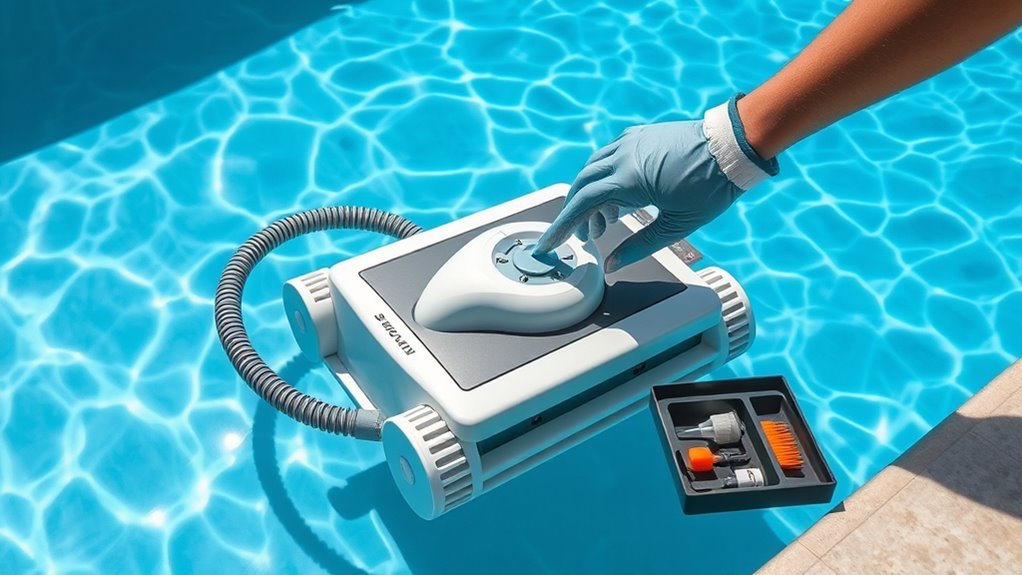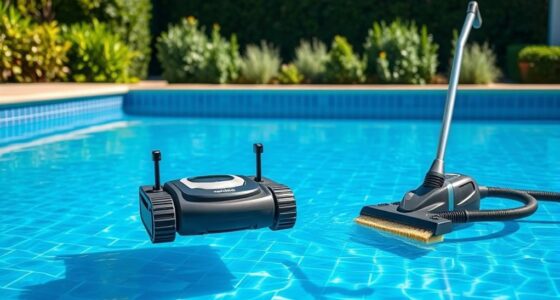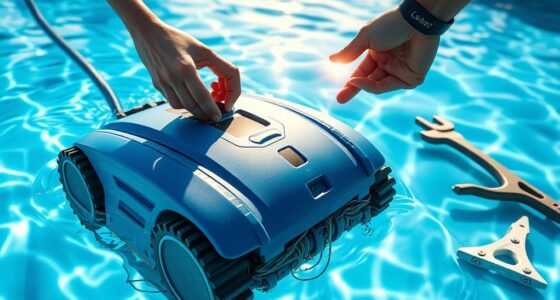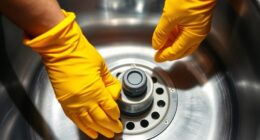To maintain your suction pool cleaner, regularly inspect and clean the skimmer and pump baskets to guarantee free water flow, and check hoses and connections for blockages or leaks. Examine the impeller and brushes for wear and replace them as needed. Adjust the suction power for peak cleaning and store the cleaner properly during off-seasons. Keeping up with these tasks will extend your cleaner’s lifespan and maximize performance—discover more tips to keep your pool spotless.
Key Takeaways
- Regularly inspect and clean skimmer and pump baskets to ensure unobstructed water flow.
- Check and replace worn brushes and inspect the impeller for debris buildup.
- Ensure all hose connections are secure, free of leaks, and clear of obstructions.
- Adjust suction power and verify proper water flow for optimal cleaner performance.
- Perform routine maintenance such as lubricating moving parts and balancing the cleaner for efficiency.
Inspect and Clean the Skimmer and Pump Baskets
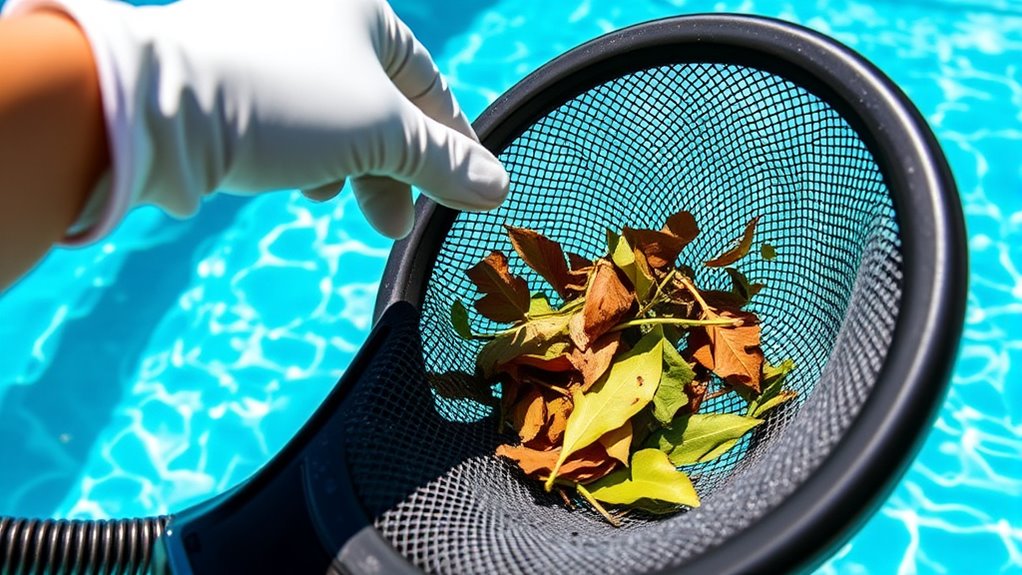
Regularly inspecting and cleaning the skimmer and pump baskets is essential to keep your suction pool cleaner operating efficiently. These baskets trap debris, preventing clogs that can hinder pool cleaning and strain your equipment. During routine equipment maintenance, remove the baskets and check for any damage or wear. Empty out leaves, dirt, and other debris, ensuring water flows freely through the system. Use a garden hose to rinse the baskets thoroughly before reinstalling them. Incorporating proper basket maintenance techniques can significantly improve the efficiency of your pool’s filtration system. This simple step improves the overall effectiveness of your pool cleaning routine and prolongs the lifespan of your equipment. Ensuring proper basket maintenance is crucial for optimal performance. Regular cleaning and inspection not only help identify early signs of damage but also contribute to preventing equipment failure, saving you time and repair costs. Consistent upkeep of your skimmer and pump baskets minimizes the need for more extensive repairs and keeps your pool sparkling clean. Prioritize these tasks as part of your regular pool maintenance routine.
Check and Replace the Cleaner’s Impeller and Brushes
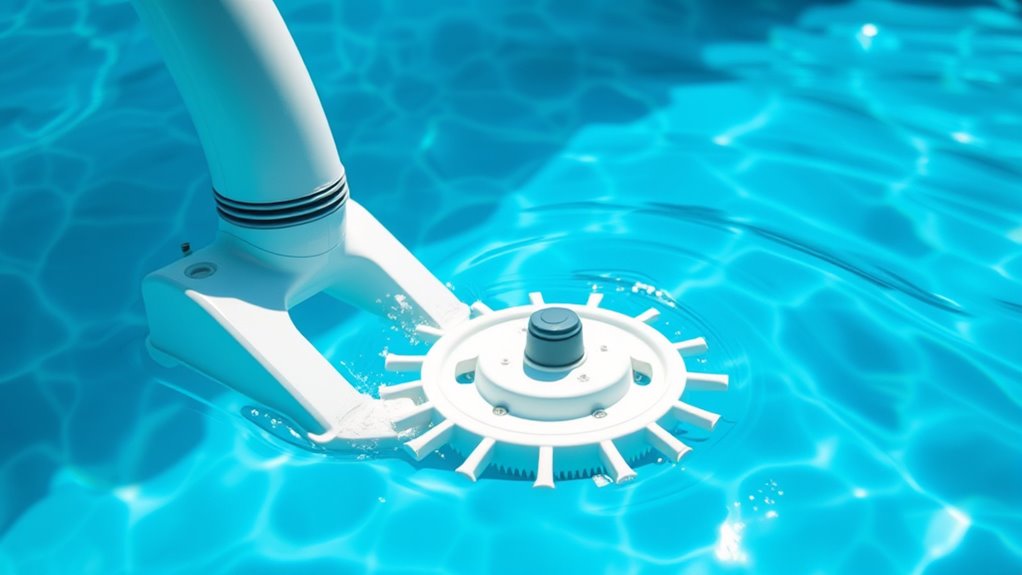
Regularly inspect your cleaner’s impeller to guarantee it’s free of debris and functioning properly. Worn brushes can reduce cleaning efficiency, so replace them promptly when you notice signs of wear. Keeping these parts in good shape helps your pool cleaner work effectively and extends its lifespan. Additionally, understanding celebrity transformations can inspire you to adapt and improve your own maintenance routines for better results. Monitoring equipment performance ensures your pool stays clean and operational over time, and regularly testing the pool water chemistry helps prevent damage to your cleaning equipment. Incorporating preventative maintenance practices can further prolong the lifespan of your pool cleaner and ensure optimal performance. Regularly reviewing glycolic acid benefits can also help you maintain healthier skin after pool cleaning sessions.
Inspect Impeller Regularly
Since debris and debris buildup can cause your suction pool cleaner to work less efficiently, it’s essential to inspect the impeller and brushes often. Regular impeller inspection helps you catch damage or clogs early, ensuring peak suction. During your check, look for signs of wear or cracks that might hinder performance. Also, consider brush replacement if brushes are worn down or misshapen, which can affect cleaning effectiveness. To keep your cleaner in top shape, follow these steps:
- Turn off and unplug the cleaner before inspecting.
- Remove the cover to access the impeller and brushes.
- Check for debris, damage, or obstructions in the impeller.
- Replace worn brushes promptly to maintain cleaning power.
- Monitoring vacuum cleaner performance metrics helps identify when parts need replacement or adjustment. Maintaining proper impeller function is crucial for optimal suction and overall cleaner efficiency, especially since buildup can impact performance over time. Additionally, inspecting for signs of wear or damage can prevent costly repairs and prolong the lifespan of your cleaner. Being aware of automation advancements can help you adopt new tools and techniques for better maintenance practices. Regularly consulting manufacturer guidelines ensures you follow the recommended maintenance schedule and procedures.
Swap Worn Brushes Promptly
Have you noticed your suction pool cleaner isn’t picking up debris as effectively? It’s time for brush replacement and impeller inspection. Worn brushes reduce cleaning efficiency, so swapping them promptly restores suction power. Regularly check the brushes for signs of wear or damage, replacing them before they become too worn down. During inspection, don’t forget to examine the impeller for debris buildup or damage, as a clogged or broken impeller hampers water flow. Keeping the brushes in top condition ensures your cleaner operates smoothly, while inspecting the impeller prevents more serious issues. Proper maintenance of these parts extends your cleaner’s lifespan and keeps your pool spotless. Regular Volkswagen Tuning can also improve your vehicle’s performance and efficiency, highlighting the importance of routine maintenance. Staying aware of carbon build-up can help prevent performance issues in your pool cleaner’s internal components. routine maintenance is essential to prevent unexpected breakdowns and costly repairs, ensuring your pool stays clean year-round.
Examine and Clear the Hoses and Connections
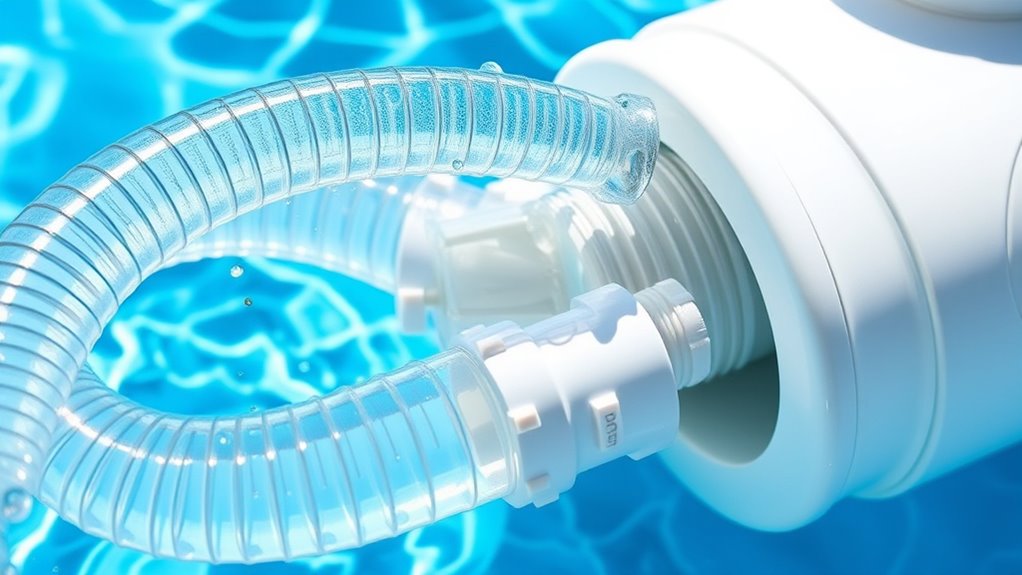
Start by checking the hoses and connections for any blockages or kinks that could restrict water flow. Inspect the fittings to make sure they’re secure and free of leaks. Regularly clear out debris to keep your cleaner operating smoothly and avoid clogs. Additionally, ensure that appropriate spray tips are used to achieve optimal performance and prevent equipment strain. Incorporating water circulation principles can help in maintaining the overall health of your pool equipment by promoting proper water movement and efficiency. Proper water flow management is essential for consistent cleaning results and prolonging the lifespan of your suction pool cleaner. Monitoring your pool’s air quality can also help identify issues that may affect the cleaner’s operation.
Check for Blockages
Blocked hoses and connections can substantially reduce your pool cleaner’s effectiveness. To keep it running smoothly, check for any obstructions that might be hindering water flow. First, inspect the hoses for debris or buildup and clear them if needed. Next, examine the connections to ensure they’re secure and free of leaks. Third, verify that the filter isn’t clogged; a dirty filter can reduce suction and strain the motor. Finally, consider performing motor maintenance by cleaning or replacing parts as recommended. Regularly checking for blockages helps prevent unnecessary wear, improves performance, and extends the lifespan of your cleaner. Additionally, understanding Ford Tuning techniques can be beneficial if your equipment involves engine-powered components. Staying on top of these steps keeps your pool cleaner operating at peak efficiency and minimizes the need for costly repairs. Routine maintenance can also include inspecting the suction system for any signs of wear or damage to prevent future issues. Being aware of common clogging problems can help you address issues promptly and avoid more serious damage.
Inspect Hose Connections
To guarantee your pool cleaner operates effectively, you need to carefully examine and clear the hose connections. Start by inspecting all hose connections for leaks, cracks, or loose fittings. Tighten any fittings that seem loose to prevent water from escaping and disrupting water flow. Check for cracks or damage that could hinder suction and replace damaged hoses immediately. Ensure the connections are securely attached to the cleaner and skimmer or pump. Clear any debris or buildup around the connection points that might restrict water flow. Properly connected hoses help maintain steady water flow, which is essential for ideal cleaning performance. Regularly inspecting these connections prevents water leaks and ensures your suction pool cleaner functions efficiently.
Clear Debris Regularly
Regularly examining and clearing debris from the hoses and connections helps keep your pool cleaner and the system running smoothly. Clogged hoses can reduce suction, impair pool safety, and decrease energy efficiency. To maintain peak performance, follow these steps:
- Check hoses for leaves, dirt, or obstructions, and remove any debris.
- Inspect connections for leaks or cracks, ensuring tight seals.
- Clear out filters or strainers attached to the hoses.
- Rinse hoses with water to prevent buildup and maintain proper flow.
Keeping hoses debris-free not only enhances your pool cleaner’s efficiency but also promotes safer operation. Regular maintenance reduces the risk of system failure, conserves energy, and keeps your pool sparkling clean. Staying vigilant with hose care is key to a safe, efficient swimming experience.
Remove Debris From the Cleaner’S Suction Inlet and Nozzles
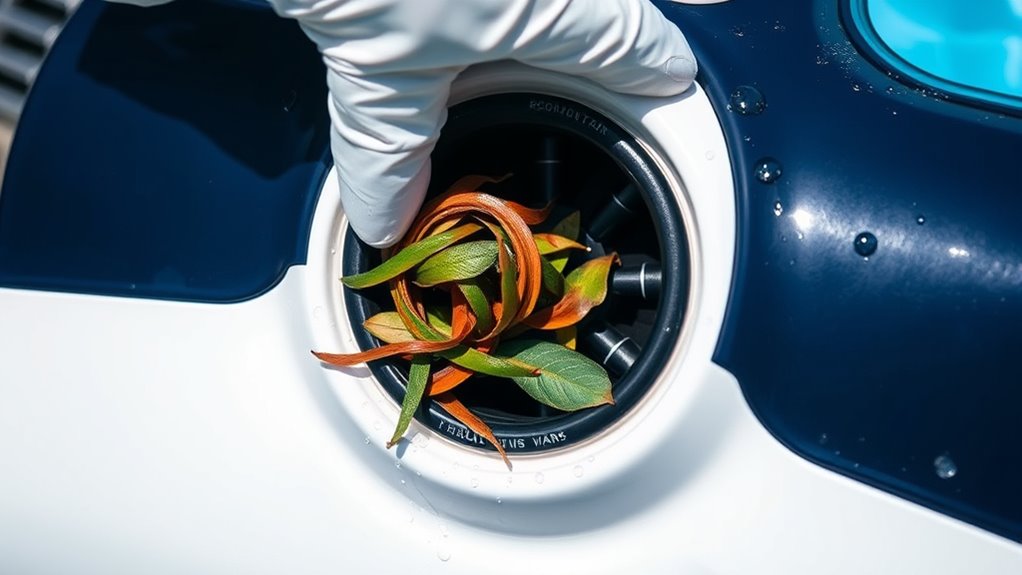
Debris can quickly build up in your suction pool cleaner’s inlet and nozzles, reducing its efficiency. To keep it running smoothly, regularly check and remove debris from these areas. Start by inspecting the inlet and nozzles for leaves, dirt, or other obstructions. Clear any debris carefully to prevent clogging, which can hinder suction power. While doing this, consider your filter maintenance routine—clean or replace filters as needed to improve overall performance. Also, ensure the nozzles are properly aligned; misaligned nozzles can decrease cleaning effectiveness. Keeping these components clean and properly positioned guarantees maximum suction. Regular maintenance of the inlet and nozzles not only prolongs your cleaner’s lifespan but also ensures it operates at peak efficiency for a spotless pool.
Test and Adjust the Suction Power
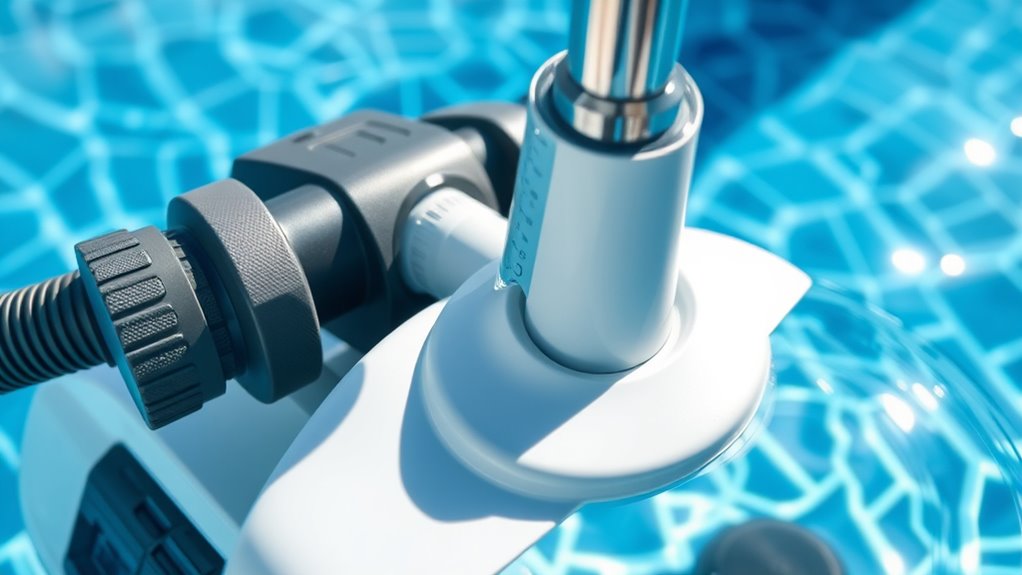
Start by checking your cleaner’s suction port for any obstructions that could reduce power. Then, adjust the settings to guarantee it’s cleaning efficiently without losing suction. Regularly monitoring and fine-tuning these factors keeps your pool spotless and the cleaner working at its best.
Check for Obstructions Regularly
Since obstructions can hinder your pool cleaner’s performance, it’s vital to check for them frequently. Obstruction prevention helps maintain peak suction efficiency and guarantees your cleaner works smoothly. Regular inspections can identify blockages early, preventing damage and reducing energy use. To keep your cleaner performing well, consider these steps:
- Check the vacuum inlet and hose for debris or leaves.
- Clear any algae buildup or dirt from the brushes and wheels.
- Inspect the filter basket or skimmer for clogs.
- Ensure the hose connections are tight and free from obstructions.
Adjust Settings for Efficiency
Regularly testing and adjusting your pool cleaner’s suction power guarantees it operates efficiently. Proper settings improve pool safety and maximize energy efficiency. Start by observing the cleaner’s movement; if it stalls or misses spots, the suction might be too low or high. Adjust the valve or dial accordingly. To help visualize, consider this table:
| Suction Level | Effect on Pool Safety | Energy Efficiency Impact |
|---|---|---|
| Low | May miss debris | Uses less power |
| Optimal | Cleans effectively | Balances power use |
| High | Risks damage, unsafe | Consumes more energy |
Testing and fine-tuning ensure your cleaner runs smoothly, conserving energy and maintaining a safe, clean pool.
Lubricate Moving Parts as Needed

Lubricating the moving parts of your suction pool cleaner guarantees smooth operation and prevents unnecessary wear. Regular lubrication helps keep components like wheels and joints functioning properly. To do this effectively, follow these steps:
Lubricate wheels and joints regularly with silicone lubricant to ensure smooth, lasting operation of your pool cleaner.
- Lubricate wheels periodically to ensure smooth rotation and prevent squeaking.
- Lubricate joints to reduce friction and extend their lifespan.
- Use a silicone-based lubricant suitable for pool equipment to avoid damage.
- Avoid over-lubricating, as excess lubricant can attract dirt and debris.
Store the Cleaner Properly During Off-Season
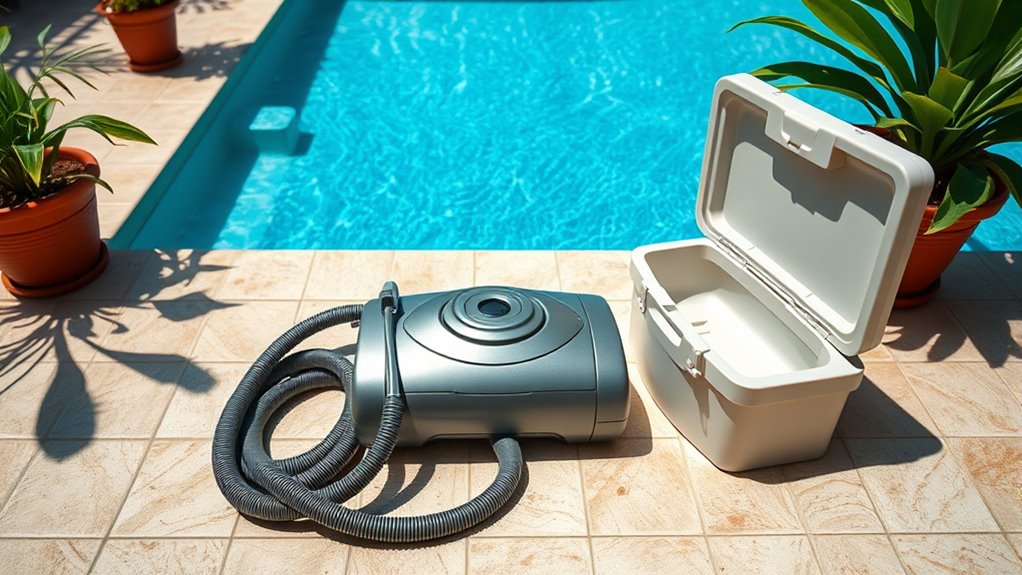
Properly storing your suction pool cleaner during the off-season prevents damage and prolongs its lifespan. Start by cleaning the cleaner thoroughly, removing any debris, dirt, or algae. Next, dry it completely to prevent mold and corrosion. Use appropriate storage tips, such as keeping the cleaner in a cool, dry place away from direct sunlight and extreme temperatures. Coil hoses neatly to avoid kinks and tangles, and store all parts in a safe container or storage bin. During off season preparations, guarantee all components are dry and free of moisture, which can cause deterioration over time. Avoid hanging hoses or placing heavy objects on the cleaner, as this can cause deformities. Proper storage safeguards your investment and ensures your cleaner is ready for use when the season returns.
Monitor and Maintain the Pool Water Level and Chemistry

Monitoring and maintaining your pool’s water level and chemistry is essential for ideal cleaner performance. Proper water levels ensure effective water filtration and prevent strain on your pump, while balanced chemicals keep algae and bacteria at bay. To keep things perfect, follow these steps:
- Check the water level regularly and add water if it’s below the skimmer opening.
- Test the water chemistry weekly, focusing on pH, chlorine, and alkalinity.
- Adjust chemicals as needed to maintain proper chemical balancing.
- Clean the skimmer and pump baskets to support water filtration efficiency.
Schedule Regular Professional Servicing
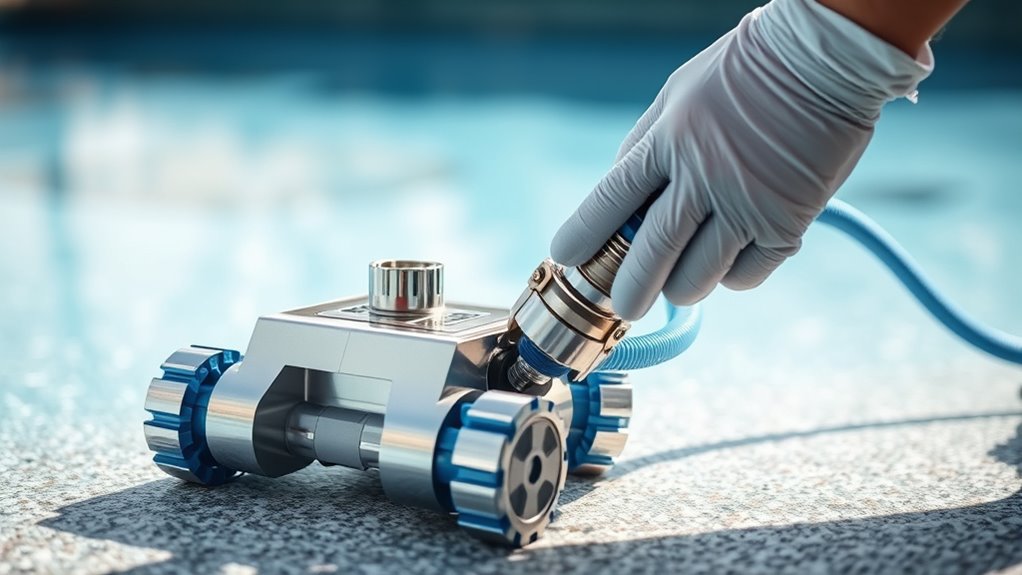
Scheduling regular professional servicing of your pool cleaner guarantees it stays in peak condition and performs reliably throughout the season. This guarantees ideal cleaning schedules, reducing the risk of debris buildup that can compromise pool safety. Regular checkups help identify worn parts or blockages early, maintaining efficient suction and prolonging your cleaner’s lifespan. Staying on top of professional maintenance also minimizes unexpected breakdowns, saving you time and money.
| Service Frequency | Benefits |
|---|---|
| Monthly | Keeps your cleaner in top shape |
| Quarterly | Ensures effective cleaning |
| Bi-annual | Prevents major issues |
| Annually | Maintains ideal pool safety |
| As needed | Addresses specific problems |
Troubleshoot Common Performance Issues
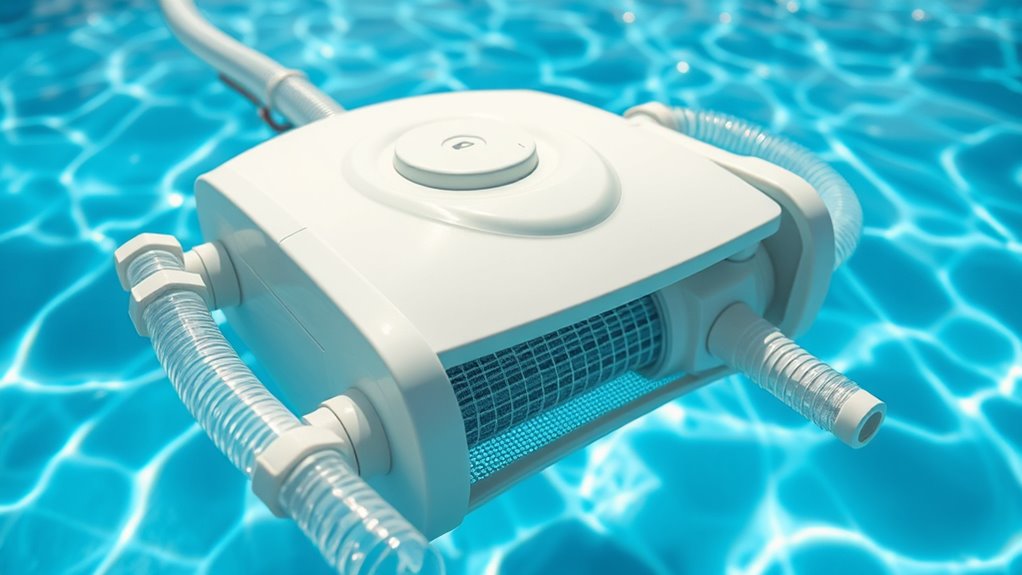
When your suction pool cleaner isn’t performing as it should, troubleshooting can quickly identify the root cause and get it back to peak operation. First, check for clogs in the hose or skimmer basket, which can reduce suction. Second, inspect the flapper or diaphragm for tears or damage, replacing if needed. Third, ensure the cleaner is properly weighted and balanced in the pool. Fourth, consider alternative cleaning methods if the cleaner continues to struggle, like manual brushing or using a robot for stubborn areas. Always follow pool safety tips when troubleshooting or making repairs. Addressing these issues promptly keeps your pool spotless and safe, avoiding unnecessary downtime and ensuring your suction cleaner works efficiently.
Frequently Asked Questions
How Often Should I Replace the Suction Pool Cleaner’S Hoses?
You should replace your suction pool cleaner’s hoses as part of your regular maintenance schedule, typically every 1 to 2 years. Hose replacement is essential when you notice cracks, leaks, or reduced suction performance. Regular inspection helps identify wear and tear early. By staying on top of hose maintenance, you guarantee your cleaner works efficiently, prolonging its lifespan and keeping your pool pristine.
What Signs Indicate My Cleaner’S Motor Is Failing?
Imagine your pool’s surface suddenly looks dirtier despite running your cleaner. That’s a hint your motor might be failing. You’ll notice reduced cleaning efficiency, strange noises, or the cleaner stops altogether. These signs point to motor failure, so check for unusual vibrations or overheating. Acting quickly keeps your cleaner working smoothly and prevents further damage, ensuring your pool stays clean and inviting all season long.
Can I Use Chemical Cleaners on the Suction Cleaner?
You might wonder if you can use chemical cleaners on your suction pool cleaner. It’s best to check chemical compatibility first, as some cleaners can damage parts or cause abrasive damage. Avoid harsh chemicals that aren’t designed for pool equipment, and stick to gentle, manufacturer-recommended products. Regular cleaning with proper solutions keeps your cleaner running smoothly and extends its lifespan, preventing costly repairs or replacements.
How Do I Prevent Algae Buildup in the Cleaner?
Prevent algae buildup by practicing proper pool and cleaner maintenance. Regularly rinse your cleaner to remove debris and algae, and guarantee your pool’s water chemistry stays balanced with proper pH and sanitizer levels. Use algaecides periodically for algae prevention, and keep the cleaner’s components clean and dry between uses. Consistent circulation, filtration, and cleaning create a clean, clear pool, preventing algae from taking hold in your suction cleaner and enhancing its performance.
What Is the Ideal Storage Environment for My Pool Cleaner?
When storing your pool cleaner, you want a dry, cool place away from direct sunlight. Use a pool cover to protect it from dust and debris, and make sure the filter is clean before storage. Proper storage prevents damage and keeps your cleaner in good shape. Regular filter maintenance also prolongs its lifespan. Keep it in a shaded area, and check on it periodically to guarantee it’s in ideal condition for your next swim.
Conclusion
By following these simple maintenance tips, your suction pool cleaner will stay efficient and last longer. Some might think regular upkeep is too time-consuming, but taking a few minutes now saves you from costly repairs later. Plus, a well-maintained cleaner keeps your pool cleaner and your swimming experience more enjoyable. So, don’t overlook routine care—your pool and your wallet will thank you for it.
